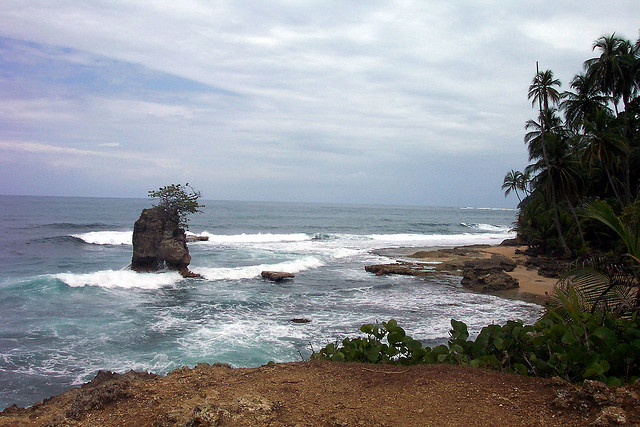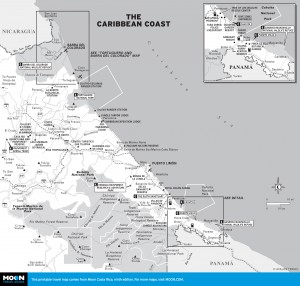
Along the shore at the Gandoca-Manzanillo Wildlife Refuge. Photo © Mercedea, licensed Creative Commons Attribution.

The Caribbean Coast
The 9,446-hectare Refugio Nacional de Vida Silvestre Gandoca-Manzanillo (Gandoca-Manzanillo National Wildlife Refuge) protects a beautiful brown-sand, palm-fringed nine-kilometer (5.5-mile) crescent-shaped beach where four species of turtles—most abundantly, leatherbacks—come ashore to lay their eggs (Jan.-Apr. is best). Some 4,436 hectares (10,962 acres) of the park extend out to sea. The ocean has riptides and is not safe for swimming. The reserve—which is 65 percent tropical rainforest—also protects rare swamp habitats, including the only mangrove forest on Costa Rica’s Caribbean shores, two jolillo palm swamps, a 300-hectare (740-acre) cativo forest, and a live coral reef.The freshwater Laguna Gandoca, one kilometer (0.6 miles) south of Gandoca village, is a lagoon with two openings into the sea. The estuary, full of red mangrove trees, is a complex world braided by small brackish streams and snakelike creeks. The mangroves shelter both a giant oyster bed and a nursery for lobsters and the swift and powerful tarpon. Manatees and a rare estuarine dolphin—the tucuxí— swim and breed here, as do crocodiles and caimans. The park is home to at least 358 species of birds (including toucans, red-lored Amazon parakeets, and hawk-eagles) as well as margays, ocelots, pacas, and sloths.
The hamlets of Punta Uva, Manzanillo (the northern gateway), Punta Mona, and Gandoca (the southern gateway) form part of the refuge. Because communities of indigenous people live within the park, it is a mixed-management reserve; the locals’ needs are integrated into park-management policies. Punta Mona Center for Sustainable Living and Education (no tel.) is a communal organic farm and environmental center. It teaches traditional and sustainable farming techniques and other environmentally sound practices. It accepts volunteers, internships are available, and day and overnight visitors are welcome ($40 pp, including boat transfers, guided tour, and kayaking). Kayaking, guided hikes, and yoga retreats are offered.
The park is easily explored simply by walking the beaches; trails also wind through the flat lowland rainforest fringing the coast. A coastal track leads south from the east side of Manzanillo village to Gandoca village (two hours), where you can walk the beach one kilometer (0.6 miles) south to Laguna Gandoca. Beyond the lagoon, a trail winds through the jungle, ending at the Río Sixaola and the border with Panamá. A guide is recommended.
ANAI (Asociación Nacional de Asuntos Indígenas, tel. 506/2224-6090 or 506/2756-8120) works to protect the forest and to evolve a sustainable livelihood through reforestation and other earth-friendly methods; it offers Talamanca Field Adventures trips throughout the southeast. Volunteers are needed for the Marine Turtle Conservation Project, which conducts research and protects the turtles from predators and poachers. Contact ANAI or ATEC (Asociación Talamanca de Ecoturismo y Conservación, tel./fax 506/2750-0398) to see how you can help.
You can hire a guide and a boat in Sixaola to take you downriver to the mangrove swamps at the river mouth (dangerous currents and reefs prevent access from the ocean). The Costa Rican Association of Community-Based Rural Tourism (ACTUAR, tel. 506/2248-9470) offers eco-minded tours, plus homestay accommodations with locals at El Yüe Agroeco-farm and other indigenous lodges.
The MINAE ranger station (tel. 506/2759-9001, 8am-4pm daily) is at the entrance to Manzanillo village; the MINAE headquarters (tel. 506/2759-9100), at Gandoca, is 500 meters (0.3 miles) inland from the beach. Entrance costs $6, but there is rarely anyone to collect the fee.
Camping is permitted in the park, but there are no facilities. The nearest accommodations are in the villages of Manzanillo and Gandoca, on the northern and southern entrances to the reserve, respectively.
The various accommodations at Gandoca are often closed in low season and include the breeze-swept Cabinas Orquídeas (tel. 506/2754-2392), run by a friendly older couple. They have 18 rooms. Four upstairs rooms have bunks and a shared bath with cold water only for $12 pp ($20 pp with meals). Others have private baths ($25 pp, or $30 pp with meals). The best bet in Gandoca is Albergue Kaniki (tel. 506/2754-1071, $17 pp), with three small dorm rooms with bunks and lots of light and cold-water baths. You can also camp on lawns. Meals are served. It rents sea kayaks and has horseback rides, plus bird-watching, hiking, and dolphin tours.
Sportfishers opt for Tarponville (tel. 506/2759-9118, U.S. tel. 406/586-5084, $100 pp, including meals, 5-day angling package from $2,030, nonanglers $825), inside the reserve. It offers sportfishing packages from five days. Simply furnished rooms have ceiling fans. Rates include meals. The lodge is available off-season for family vacation rentals (June-Aug. and Nov.-Feb., low season $171, high season $221). It comprises two adjoining houses: the fourbedroom Coral Reef House and the three-bedroom Dolphin Lodge.
Punta Mona Center for Sustainable Living and Education (tel. 506/2614-5735 or 506/8391-2116, $40 pp, including meals) operates on a community living basis and has cabins. ANAI welcomes volunteers to its Finca Loma (tel. 506/2759-9100), an ecotourism project beside the turtle hatchery. You need to sign up for a six-week minimum stay and may find yourself doing all kinds of physical chores. There is no electricity.
Getting There
You can drive to Gandoca village via a 15-kilometer (9.5-mile) dirt road that leads north from the Bribrí-Sixaola road; the turnoff is signed about three kilometers (2 miles) west of Sixaola. Keep left at the crossroads 1.5 kilometers (1 mile) down the road. If you get caught short of money, there’s a roadside 24-hour ATM at Finca Sixaola, midway to Gandoca.
Excerpted from the Ninth Edition of Moon Costa Rica.